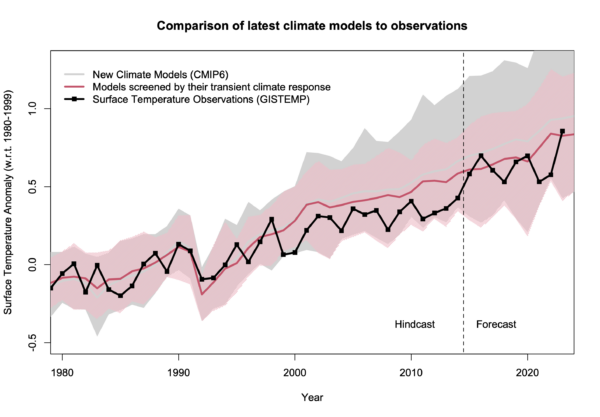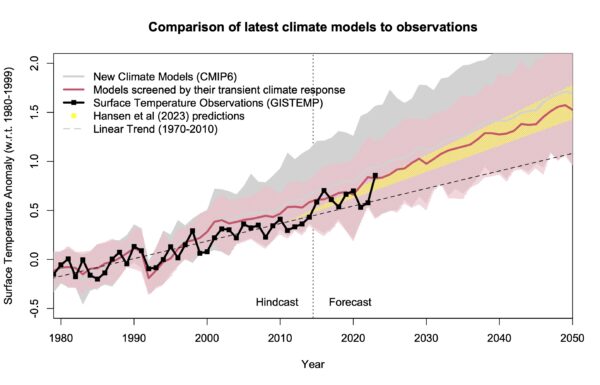There has been a lot of commentary about perceived disagreements among climate scientists about whether climate change is, or will soon, accelerate. As with most punditry, there is less here than it might seem.
Last year, Jim Hansen and colleagues published a long paper that included a figure suggesting that they expected that global temperature trends from 2011 to increase above the recent linear trends.
This has meshed with another argument around whether an acceleration of global temperatures in recent decades can already be detected. Tamino has made a case that it can be, if some of the ‘noise’ in the record is factored out (notably the linear impacts of ENSO and volcanoes). However, it not so obvious that the recent El Niño can be so easily removed in such a way. In my recent Nature commentary, I pointed out the difficulties explaining quantitatively why 2023 was so warm. Without further clarity on that, deciding whether we have yet seen an acceleration or not is a bit ambiguous.
Another view of the future is given by the results of climate models. We’ve discussed some of the issues with the latest CMIP6 round of simulations many times in recent years, nonetheless, by screening the model ensemble based on the likely range of climate sensitivity, we can create projections that align closely with assessed projections from the last IPCC report. These projections are the basis of our updated comparisons of CMIP6 models to observations, and specifically this graph:

It is worth remembering what the CMIP6 projections are based on. These simulations used historical GHG concentrations and aerosol emissions to 2014, and a mid-range scenario (SSP2-4.5) thereafter, which has continued increases of CO2 and CH4 as well as forecast decreases in aerosol emissions. The screening uses the likely range of 1.8 to 2.2ºC of transient climate response, roughly equivalent to to a screening uses equilibrium climate sensitivity of 2.5 to 4ºC for a doubling of CO2 (Hausfather et al, 2022).
The question naturally arises as to who is correct, Hansen et al or the models?
We can assess this by extending our graph to 2050, and plotting Hansen et al’s projected range on top:

Remarkably, the Hansen et al projections are basically indistinguishable from what the mean of the TCR-screened CMIP6 models are projecting. Or, to put it another way, everybody is (or should be) expecting an acceleration of climate warming (in the absence of dramatic cuts in GHG emissions) (CarbonBrief has a similar analysis), even if we might differ on whether it is yet detectable.
References
- J.E. Hansen, M. Sato, L. Simons, L.S. Nazarenko, I. Sangha, P. Kharecha, J.C. Zachos, K. von Schuckmann, N.G. Loeb, M.B. Osman, Q. Jin, G. Tselioudis, E. Jeong, A. Lacis, R. Ruedy, G. Russell, J. Cao, and J. Li, “Global warming in the pipeline”, Oxford Open Climate Change, vol. 3, 2023. https://dx.doi.org/10.1093/oxfclm/kgad008
- G. Schmidt, “Climate models can’t explain 2023’s huge heat anomaly — we could be in uncharted territory”, Nature, vol. 627, pp. 467-467, 2024. https://dx.doi.org/10.1038/d41586-024-00816-z
- Z. Hausfather, K. Marvel, G.A. Schmidt, J.W. Nielsen-Gammon, and M. Zelinka, “Climate simulations: recognize the ‘hot model’ problem”, Nature, vol. 605, pp. 26-29, 2022. https://dx.doi.org/10.1038/d41586-022-01192-2
